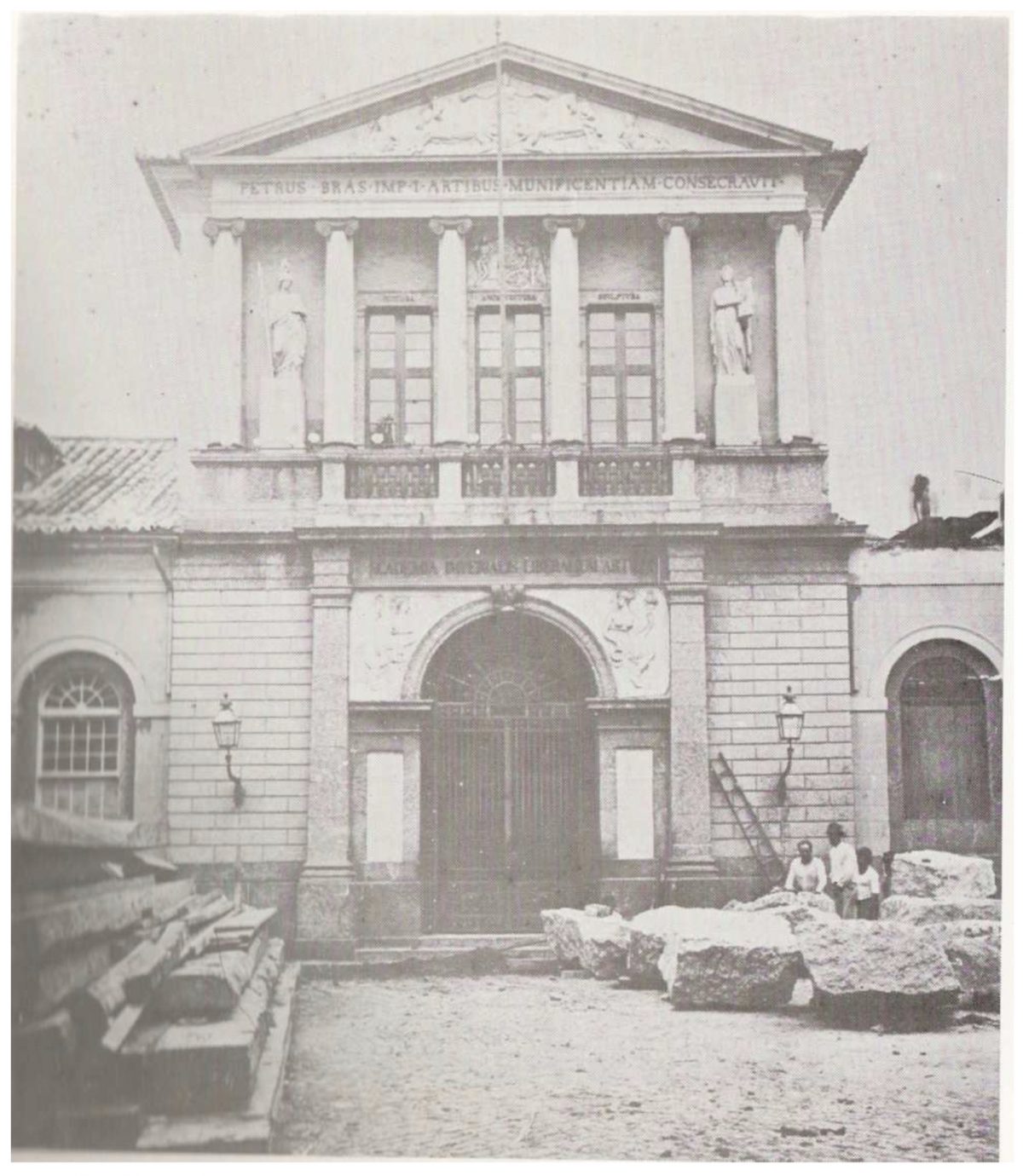Down one of the many paths of Rio de Janeiro’s botanical garden stands a grand neoclassical portal, the arched entrance, classical columns, frieze and pediment are all that remain of the Imperial Academy of Fine Art (figure 1). The plan of the Academy shows that it was once much larger (figure 2), after being built from 1816 to 18241 it accommodated classes on a variety of artistic methods as well as architecture and design.2 The building was designed by artist and architect Auguste-Henri-Victor Grandjean de Montigny. Grandjean de Montigny was a member of a group of 16 artists from the French Académie des Beaux-Arts who were invited by the Portuguese crown to found the Brazilian Academy. The Imperial Academy of Fine Art in Brazil served as a foundation for European cultural hegemony as a further layering of imperial and colonial power in Brazil during the 19th century and beyond. While there were attempts at using this platform to build a uniquely Brazilian national identity the Academy ultimately prevented an original Brazilian cultural identity from forming at a national level during this time.
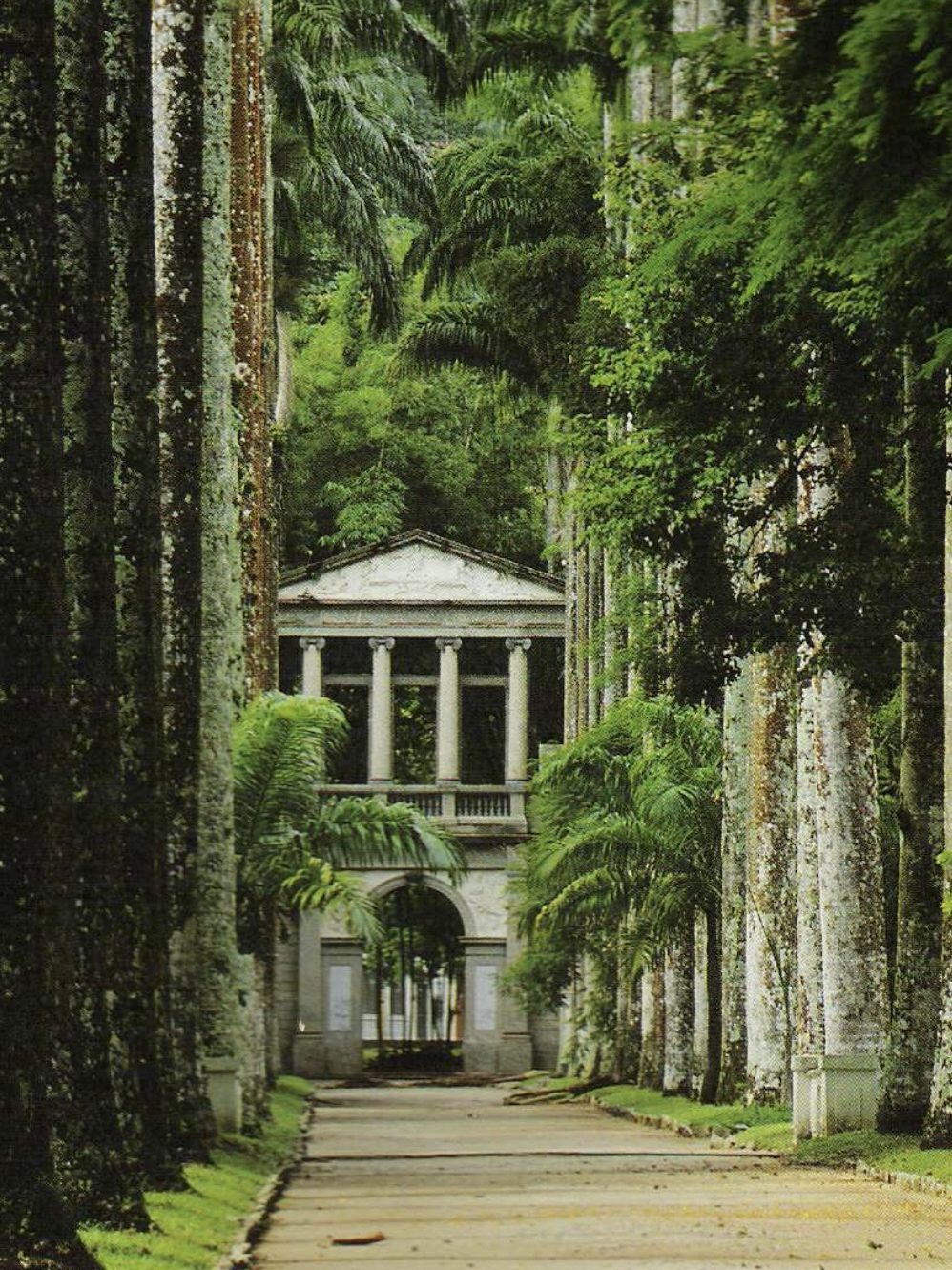
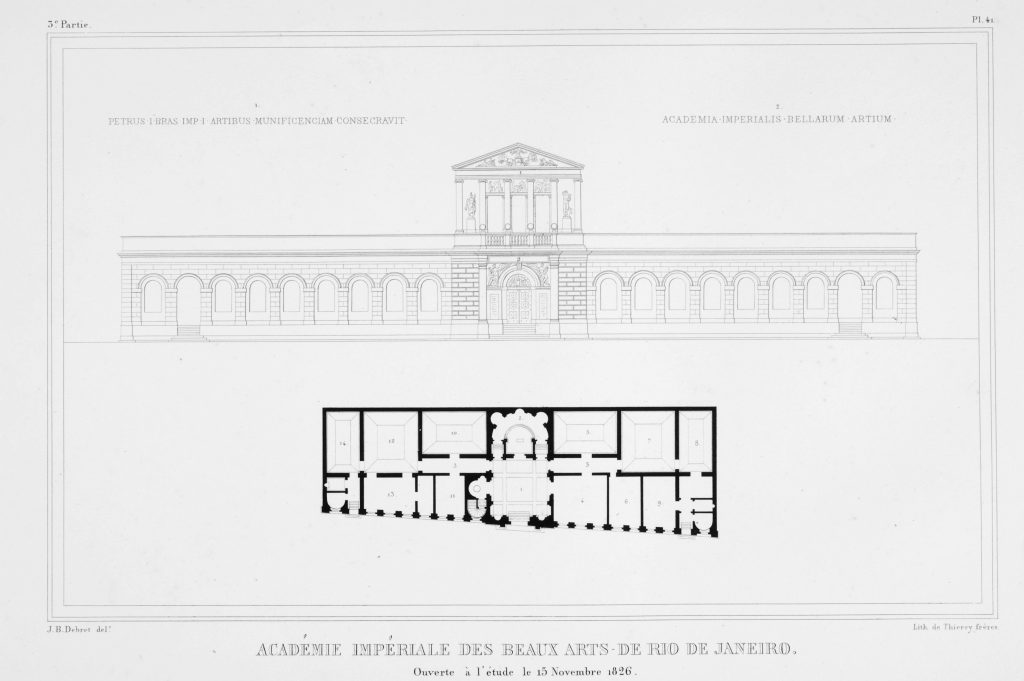
The context that the Imperial Academy was founded in is very unique and it marks a major turning point in Brazilian culture and society. Pre-19th century Brazil was under intense colonial rule by way of a system of rural oligarchs and military occupation. Under the de facto rule of Marquês de Pombal the main patron of art was the Catholic church and there was strong suppression of industry, new technologies such as the printing press and any sign of pro independence protests.3 This left Brazil behind Europe, and even other European colonies, in terms artistic and architectural style as well as education of the masses. This all changed when the Portuguese crown, fleeing Portugal after Napoleons invasion in 1807, arrived in Rio de Janeiro in 1808. The Queen and Prince Regent D. João VI brought a consort of 15 000 people which drastically influenced the society and culture of Rio, which had at the time, a population of 50 000 people. In an effort to reform and rebuild the society into something deemed worthy of supporting a European royal family the Prince commissioned the aforementioned group of 16 French artists and designers to found an academy of art and science, this group came to be known as the French Mission of 1816.4
1 M. B. Silva, s.v. “Grandjean de Montigny, Auguste Henri Victor (1776–1850),” in Encyclopedia of Latin American History and Culture (Detroit, MI: Charles Scribner’s Sons, 2008), accessed February 17, 2021, https://link.gale.com/apps/doc/CX3078902598/GVRL?u=ubcolumbia&sid=GVRL&xid=c06aa397.
2 Rafael C. Denis and Colin Trodd, “Academicism, imperialism and national identity: the case of Brazil’s Academia Imperial de Belas Artes,” in Art and the Academy in the Nineteenth Century (Manchester: Manchester University Press, 2000), 56.
3 Ibid, 55.
4 A. Valle, “From “Academy” to “School”: Transformations in the Academy of Fine Arts in Rio de Janeiro (1816–1930),” in Academies and Schools of Art in Latin America (London: Routledge, 2020), 34.
For a building with the purpose of facilitating the creation of a new society around the Portuguese crown the Academy building was fittingly designed in a neoclassical style to fit the European ideals. Grandjean de Montigny, who studied under architects and designers Charles Percier and Pierre Fontaine, followed these ideals in most of his work, the Academy being no exception.5 The neoclassical style of the building can be clearly identified through its use of a classical system of greco-roman columns on top of which sits a frieze and pediment, forming a grand and imposing portal to the building (figure 3). Grandjean de Montigny is largely attributed to introducing neoclassical architecture to Brazil at this time through a number of works, with the Academy building being one of the more prominent. The building and educational institution has gone through many stages and changes throughout its life, one of the more more drastic being the renaming of the Imperial Academy of Fine Arts to the National School of Fine Art in 1890 (figure 4), which came after the First Republic of Brasil was formed in 1889. This was not only a name change however, as it brought in a wave of dismissals of professors that made way for a new group of artists trained in Italy and France to gain control of the Academy.6 The neoclassical design of the Academy building was the first sign of how the Academy would impose European artistic and cultural ideals on the burgeoning Brazilian society in this new era but it clearly did not end there.
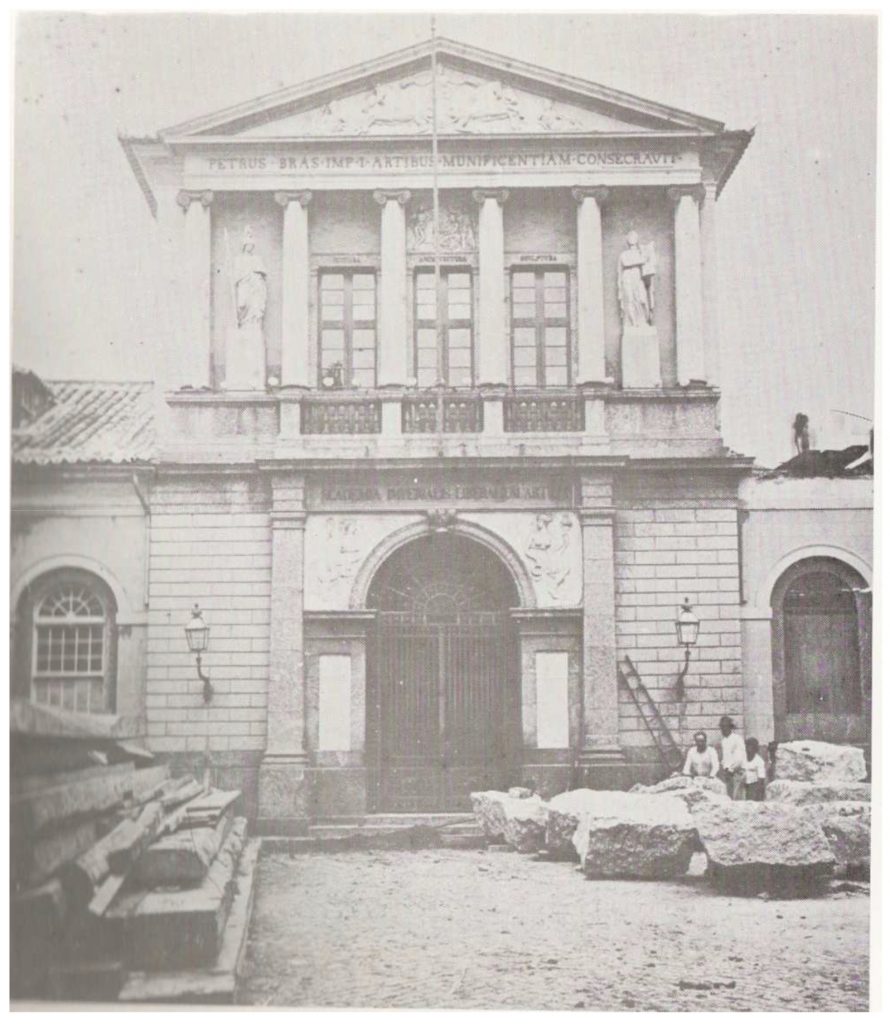
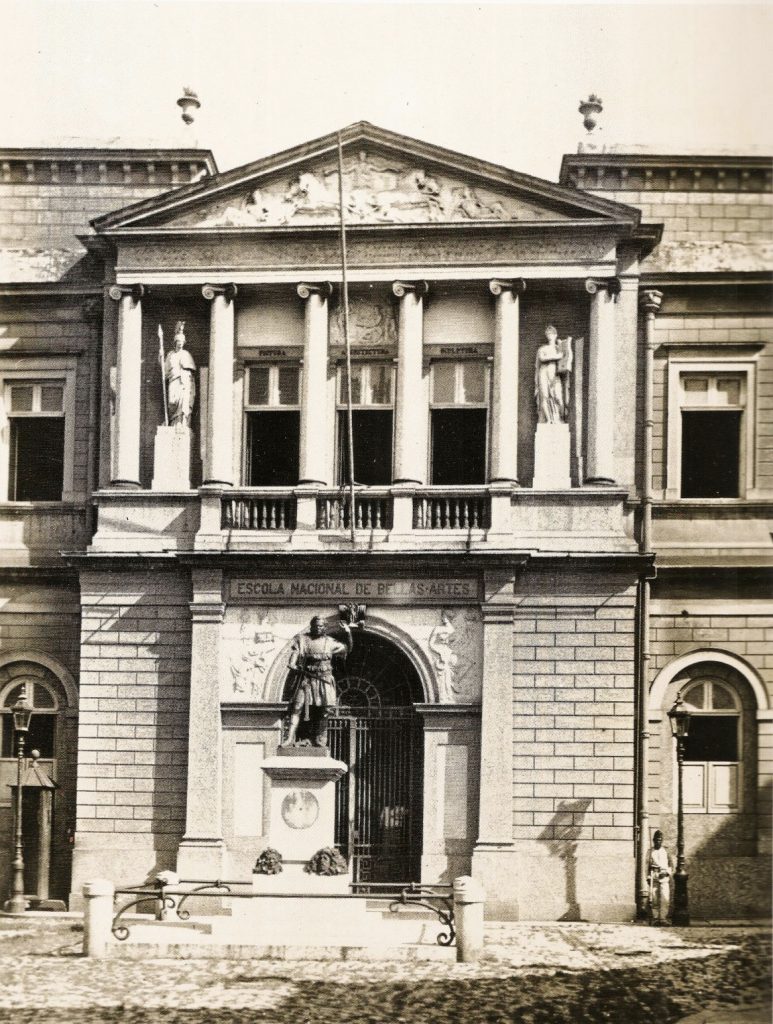
At a time when Brazil was just beginning to develop as a nation state, the Academy introduced artistic and architectural styles that where directly taken from the ideals of the Académie des Beaux-Arts in France, effectively prohibiting any development of an original Brazilian artistic style. This was not always an agreeable path for Brazilian artist as within the European colonial structure of the Academy there was at one point an effort to organize and develop a uniquely Brazilian identity through art. This revolution of sorts was led by the director at the time, Manuel de Araújo Porto-Alegre. Porto-Alegre aimed to modernize the collection and teachings of the academy as well as instigate discourse on the topic of a distinct Brazilian cultural identity that differs from its colonial past. His efforts ultimately failed as within this pro European institution and on the international stage there was a lack of support and even distain at the thought of Brazil forming a unique national identity apart from its colonial past. This comes mainly from the opinions of many European societal elites believing that the lower class, indigenous and mixed race populations where true to the country but lacked the originality to produce a cultural identity and the immigrant upper class as skilled enough for the task but lacking in cultural specificity.7
5 Valle, “From “Academy” to “School”, 34.
6 Ibid, 38.
7 Rafael Cardoso, “The Brazilianness of Brazilian Art,” Third Text 26, no. 1 (February 2012): 20, doi:10.1080/09528822.2012.647643.
The Imperial Academy of Fine Art in Rio de Janeiro, Brazil was a platform from which a further layer of imperial and colonial power was extended over Brazil in the form of European cultural ideals. The development of Brazilian art in later centuries was heavily influenced by European ideals where it could have been more influenced by the cultures of Brazilian indigenous peoples and enslaved African peoples and their decedents. The founding of the Imperial Academy by the French mission of 1816 brought neoclassical art and architecture to Brazil in a major way. Its founding marked a turning point in Brazilian culture and society, developing both in a Euro-influenced way. Despite some pushback from members of the Academy during the 1800s the renaming of the Academy to the National School of Fine Art and transition of power to artists trained in Europe solidified the development of a culture heavily influenced by European ideals. While the Imperial Academy of Fine Art might have served as a platform for original Brazilian art and culture, the Eurocentric power structure and its ideals prevailed in exerting a new form of colonial control over Brazilian culture.
Bibliography
Cardoso, Rafael. “The Brazilianness of Brazilian Art.” Third Text 26, no. 1 (February 2012), 17-28. doi:10.1080/09528822.2012.647643.
Denis, Rafael C., and Colin Trodd. “Academicism, imperialism and national identity: the case of Brazil’s Academia Imperial de Belas Artes.” In Art and the Academy in the Nineteenth Century, 53-67. Manchester: Manchester University Press, 2000.
Silva, M. B. “Grandjean de Montigny, Auguste Henri Victor (1776–1850).” In Encyclopedia of Latin American History and Culture, 2nd ed., 503-504. Vol. 3. Detroit, MI: Charles Scribner’s Sons, 2008. Accessed February 17, 2021. https://link.gale.com/apps/doc/CX3078902598/GVRL?u=ubcolumbia&sid=GVRL&xid=c06aa397.
Valle, A. “From “Academy” to “School”: Transformations in the Academy of Fine Arts in Rio de Janeiro (1816–1930).” In Academies and Schools of Art in Latin America, 1st ed., 34-48. London: Routledge, 2020.
Images
figure 1. The portal of the Imperial Academy of Fine Arts, Rio de Janeiro Botanical Gardens, Brazil. Current day. Neoclássico no Brasil (Séc. XVIII – XIX). https://docplayer.com.br/5820071-Neoclassico-no-brasil-sec-xviii-xix.html
figure 2. Plan and elevation of the Imperial Academy by Jean-Baptiste Debret. 1826. Biblioteca Brasiliana. https://digital.bbm.usp.br/handle/bbm/3767
figure 3. Brazilian Imperial Academy of Fine Art, during construction. Early to mid 1800s. Neoclássico no Brasil (Séc. XVIII – XIX). https://docplayer.com.br/5820071-Neoclassico-no-brasil-sec-xviii-xix.html
figure 4. Brazilian National School of Fine Art, After renaming and during the First Republic. Late 1800s to early 1900s. Neoclássico no Brasil (Séc. XVIII – XIX). https://docplayer.com.br/5820071-Neoclassico-no-brasil-sec-xviii-xix.html
